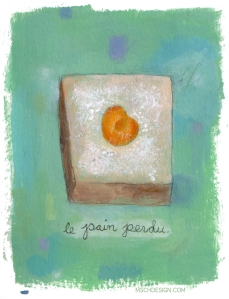Pain Perdu: Childhood love of French custard and bread
28 Thursday Jun 2012
A Woman’s Paris™ in Food
Tags
Boulangerie, Calixte, Christophe Raoux recipe for pain perdu, Fete de la Bastille, France, French toast, Frere Jacques nursery song, Ile de la Cite, Ile Saint-Louis, Notre Dame, Original French toast Mark Schatzker, pain perdu, Paris, Patisserie
Share it
By Barbara Redmond
Paris was hot. Avenues and side streets still held heat from the week before. Windows shut tight, drapes drawn to keep in the cool or flung wide to invite a breeze. Parisians left the city for the country soon after Fête de la Bastille. Hand-painted signs on shops and cafés read: fermé en vancances. I left early too, for the Seine, in search of cool. I walked, connecting patches of shade, and crisscrossed my way on boulevard Henri IV to the Seine. On pont de Sully, I could retreat from the sun and stroll the long narrow street of Île Saint-Louie that cut through its center of restaurants, cafés, shops, ice cream parlours, and boulangerie—most, now closed for the season or because it was Sunday. I’d pass Saint-Louis-en-L’Île Church on my left and, soon after, my favorite pâtisserie, Calixte. It was too hot for a buttery croissant.
I stopped at Calixte, surprised that their counters were sparse. They, too, soon would be fermé en vancance. Inside the display were three trays: one held croissants, the other two tarts. Behind the counter were a basket of baguettes and an armful of boule on a shelf. Near the window was a porcelain platter, which held three slices of pain perdu, stale slices of pain de mie soaked in a rich-custard of cream and egg, sautéed and dusted generously with Confectioners’ sugar. In the center of each was a small apricot half, caramelized from sautéing in the pan with the pain perdu, in French, literally “lost bread,” (known also as French toast). I had never seen this confection in a pâtisserie or boulangerie; only on a restaurant menu—or in the kitchens of my grandmother and mother. I left Calixte, grasping my piece of childhood nestled in its brown parchment bag.The air from the Seine was sweet and cool as I crossed pont Saint-Louis that linked Île Saint-Louis with the Île de la Cité. From the bridge, I could see the gardens of Notre Dame de Paris where I could sit on a green wooden bench in the shade of Horsechestnut trees and eat my pain perdu. Din, dan, don. Din, dan, don, called out the bells of Notre Dame.
Frère Jacques, frère Jacques,
Dormez-vous? Dormez-vous?
Sonnez les matines! Sonnez les matines!
Din, dan, don. Din, dan, don.
Parlez-vous française? Grandmother would ask, parlez-vous française? Her question, asked twice in a row, always followed several rounds of Frère Jacques, the nursery song that we would sing together. She loved to sing, especially while she cooked. Unsophisticated at that age, I thought she named me “Polly Vu.” (French was not her native tongue.)
Sunday mornings grandma made French toast: leaving it to bathe for an eternity in custard of cream, egg and sugar. Without breaking, she would pierce the crust with a fork and slide it into a pan of heated butter where it browned and caramelized, first on one side before flipping it to the other. Plumped and with a heavy dusting of Confectioners’ sugar she transferred it to our plates, nice and hot.
Din, dan, don. Din, dan, don, the Parish bells from St. Joseph’s sounded, calling the neighborhood to services. From the dining room of my grandparents’ home, we would watch as the last sister scurried from the convent across the street to make it in time for 7:30 mass.
Now settled on my bench in the shade, I tore off a piece of pain perdu half-hidden inside its parchment bag then took a bite.
Din, dan, don. Din, dan, don, clamored the bells of Notre Dame rising above the hubbub of the city. I listened spellbound, sitting near the display of roses and small statues placed around the outside of the church, its flying buttresses and towering gargoyles.
Pigeons, corpulent and ripe for Coquelets sur Canapés, broke into chaos every time tourists’ hurled chunks of baguettes—playing games of divide and conquer with the stout gray- and white-plumaged birds. Order restored, armies of pigeons, following the leader, marched up the garden path and then marched down again.
Din, dan, don. Din, dan, don. A nun, in full habit, whooshed past a row of a dozen small roses: she ran fast—even faster—past the old church in Paris that was covered with vines and past a young, precocious child with curly blond hair tending a single rose which he tenderly protected with a wind screen and kept under a glass dome on his tiny spot. A haven for children, trying to tame the butterflies they chase.
Slowly, I ate piece after piece of this succulent treat, tender and delicious, protected inside its parchment bag: random bits of childhood.
The sweltering summer heat was too much. Dying of thirst, I tossed the last morsel high into the air before readying myself for the cool of the sanctuary inside Notre Dame.
Descending from the fearsome-looking Horsechestnut trees and towering gargoyles swirled thousands of birds, and from the mounds near the roses stormed legions of pigeons—a fierce, squabbling ruckus to catch the last piece of custard and bread.
I fled for the sanctuary of Notre Dame whooshing past the quarreling birds; past old men on benches and elderly women, shoes clattering on cobblestones; past babies in strollers; past the golden-haired boy tending his rose; and past a single, large red balloon floating over the gray-blue atmosphere of the old Paris quarter.
“Ah, le pain perdu.”
RECIPE FOR PAIN PERDU: French toast
Making Pain Perdu, the Original French Toast, by Mark Schatzker. ABC NEWS explore, Condé Nast Traveler, (June 12, 2008).
“Christophe Raoux of the L’école de Cuisine d’Alain Ducasse made this for me in Paris.” — Mark Schatzker
Ingredients
– Milk
– Cream
– Eggs
– Sugar
– Bread (It can be brioche, baguette, challa or plain old American white.)
Directions
– Crack two eggs into bowl
– Add sugar
– Beat the mixture
– Add milk (about ½ cup)
– Add cream
– Continue whisking until you get a consistent color.
– Pour the mixture into wide bottom dish or pan
– Now cut your bread into slices and drop them into the mixture
– Soak each side for five minutes.*
* That’s the secret. You soak it for a lot longer than you think.
Turn the heat on your range. Take your frying pan—now here’s the second secret and it’s a biggee. The first thing you add to the pan is sugar. Let the sugar sit in the heat for a while then add a little water. That’s going to start to boil. Go ahead and add a bit more sugar. Add butter… a whole ton.
So you got your butter, your sugar and your water boiling away. Roll it around until the liquid turns a golden brown. Now you are ready to add your bread.
 Barbara Redmond, publisher of A Woman’s Paris®, is a long-time Francophile and travels to Paris every chance she gets. Her stories about Paris and France have been published in AWP® and republished, with permission, by other blogs and publications. Barbara has presented programs on French fashion and food, and has been a guest speaker for students planning their study abroad. She serves as an advisory board member at the University of Minnesota College of Design and is an active student mentor. Barbara has been recognized for excellence in art by international and national organizations and publications. Prints of her fine art paintings are in collections in Europe and North America and are available for purchase.
Barbara Redmond, publisher of A Woman’s Paris®, is a long-time Francophile and travels to Paris every chance she gets. Her stories about Paris and France have been published in AWP® and republished, with permission, by other blogs and publications. Barbara has presented programs on French fashion and food, and has been a guest speaker for students planning their study abroad. She serves as an advisory board member at the University of Minnesota College of Design and is an active student mentor. Barbara has been recognized for excellence in art by international and national organizations and publications. Prints of her fine art paintings are in collections in Europe and North America and are available for purchase.
You may also enjoy A Woman’s Paris® post, Paris, a particular shade of gray, by Mary Evans a former cooking school director and founder of The Write Cook. Mary recalls the cozy refuges in her long ago memories of Paris and shares her recipe for Chicken Bouillabaisse.
A behind-the-scenes look at French parenting, by au pair Alyssa Glawe who asks, “How do the French have such polite and courteous children without lifting a finger?” For Alyssa, every day leads to new cultural shocks and humorous situations.
For the love of yaourt (yogurt), by Michelle Hum who writes about her love of French yaourt: a tangy, creamy, dairy product that can stand by itself—although a dab of honey or handful of fresh fruit never hurts. Recipe included for Gateau au Yaourt au et au Citron (Lemon Yogurt Cake) by Ina Garten.
Boudin blanc – yes, chef! by Barbara Redmond, who shares her experience making the traditional French Christmas sausage in her home kitchen with a professional butcher.
Tartiflette: French Comfort Food, by Michelle Hum who shares a traditional French hot dish enjoyed during ski season in the Alps as a form of warm, savory comfort. Tartiflette: a French dish of potatoes, bacon, and Reblochon cheese. Recipe and video guide included courtesy of Head Chef of London’s Coq d’Argent, Michael Weiss, who provides his own version of this Alpine specialty.
French Onion Soup – a Paris meal to remember, by Michelle Hum who recalls the aroma of sweet caramelized onions, dry wine, and rich broth rising from the steam from her bowl. With the first taste—serendipity. Recipe included for Julia Child’s Soupe à l’oignon (French onion soup) from her cookbook, The Way to Cook.
Text copyright ©2012 Barbara Redmond. All rights reserved.
Illustration copyright ©2012 Barbara Redmond. All rights reserved.
barbara@awomansparis.com


